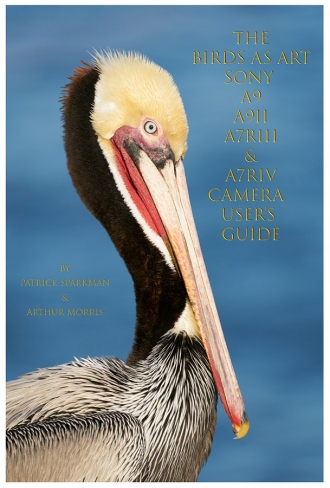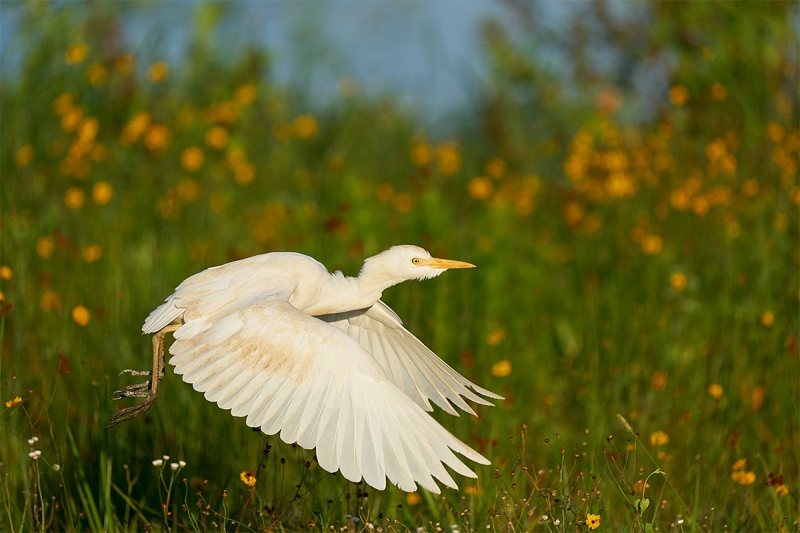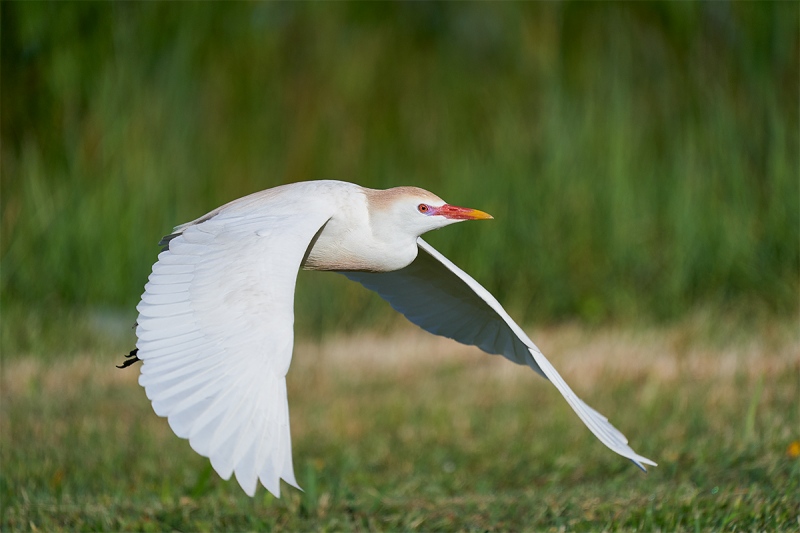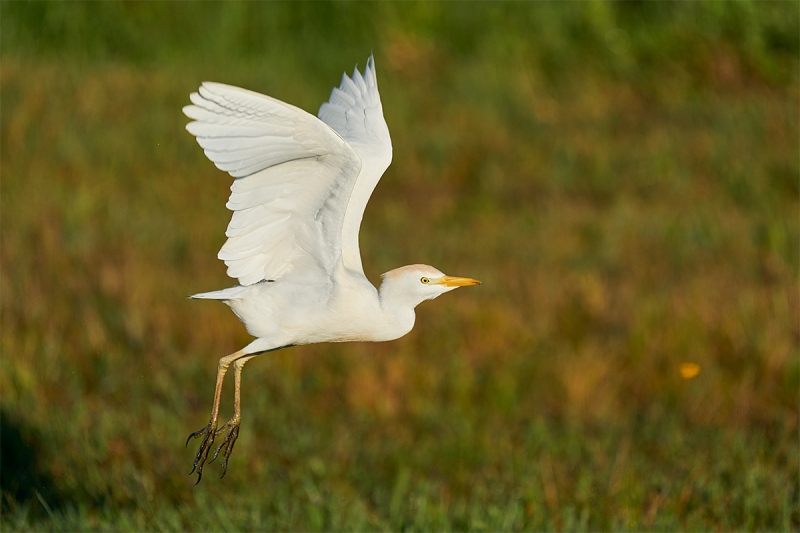What’s Up?
When I poked my head out the door on Sunday morning at about 7:00am, it was raining pretty hard. By 8:00am, it was down to a drizzle, and still, so I got my 100-400/7r iv quasi-macro rig from the Sequoia and photographed some Firebush blossoms. By 8:15, the rain had stopped, so I drove down to the lake. A quick drive-around revealed no birds other than the two dozen Black Vultures spaced out on the South Peninsula flapping their wings to dry off a bit. I passed on those because I did not want to shoot at ISO 5000. When I got back to the base of the pier, I remembered that the mudflats were covered with zillions of mayfly carcasses so I grabbed the SONY 24-105 with an a9 ii on it. (I should have used the a7r iv.) I always wear my surf booties down to the lake just in case. So I slopped around in the mud — and as it turned out, I made a few really good pattern shots.
Off to my left, I noticed a crane stand up. It was the same bird that had been hanging out in the area, seemingly for forever. I wrote in the blog recently that the eggs were likely infertile. As I approached, I noted a day-old chick. (I had seen two eggs on Friday.) I hustled back to the car, grabbed the 600 f/4, the 7r iv, and the Induro 404L tripod with the FlexShooter Pro on top, and stayed with the bird as it sat on the nest with the tiny chick wandering around a bit at times and at times climbing atop the adult to brood amongst the parent’s feathers. After an hour, the adult bird stood up revealing a just-hatched chick and a very wet, soggy eggshell. As the really tiny chick tried to stand up, its nest-mate ran at it and pecked it relentlessly driving it out of the nest. In a few moments, things calmed down so I stayed with the new family for a while longer.
As I moved slowly, the adult was completely at ease with my presence. As there was a lot of tall grass right around the nest, photography was difficult. The cloudy skies created a huge softbox and working with the f/4 lens on a tripod allowed me to create some nice images at reasonable shutter speeds. At times, it got bright enough for me to add the 1.4X TC. I got back for breakfast at eleven and made two more trips to the lake that day, the first after breakfast, the second after my swim and my second meal. (Remember intermittent fasting?) I learned a ton about crane behavior during the six hours I spent observing and photographing the birds. I will share more when I get a chance to publish some of the images from that most memorable Mother’s Day.
I was very glad to see that the smaller chick had survived its first day.
The forecast for today — Monday 11 MAY 2020 — is for clear skies with north winds so I will be heading down early but with the sun out, I will likely not spend much time (if any at all) with the two chicks.
Consider leaving a comment and letting us know which of today’s three featured images is youor favorite. And why.
BIRDS AS ART
BIRDS AS ART is registered in the U.S. Patent and Trademark Office.
|
|
|
Click on the image to enjoy a larger version. The SONY e-Guide by Patrick Sparkman and Arthur Morris |
The Sony Camera e-Guide (PDF) and videos Info
Yesterday I prepared the final PDF for the Sony Camera e-Guide. It will not be available in the store until early next week but you can order yours right now. The cost of the SONY e-Guide is $100.00 US and will include one of the four (4) camera set-up videos — we offer one video each for the a7r iii, the a7r iv, the a9, and the a9 ii — and the written guide with the galleries. Additional camera videos are $25.00 each The guide is now done.
If you would like to order the e-Guide now, please send a Paypal for $100 US to birdsasart@verizon.net and be sure to include the words “SONY e-Guide” in the Paypal e-mail along with the name of your camera or cameras so that you can receive the correct video or videos. Note: please add $25 for each camera video after the first. And please be sure to type your e-mail address into your Paypal order. Then be sure to send a copy of the Paypal transaction to me via e-mail.
BIRDS AS ART
BIRDS AS ART is registered in the U.S. Patent and Trademark Office.
SONY 200-600 Update
Steve Elkins now has seven SONY 200-600s in stock; one of them surely has your name on it. Contact Steve as below to save $50.00.
Money Saving Reminder
If you need a hot photo item that is out of stock at B&H, would enjoy free overnight shipping, and would like a $50 discount on your first purchase over $1000.00, click here to order and enter the coupon code BIRDSASART at checkout. If you are looking to strike a deal on Canon or Nikon gear (including the big telephotos) or on a multiple item order, contact Steve Elkins via e-mail or on his cell at (479) 381-2592 (Eastern time) and be sure to mention your BIRDSASART coupon code and use it for your online order. Steve has been great at getting folks the hot items that are out of stock at B&H. Those include the SONY a7r IV, the SONY 200-600, the SONY 600mm f/4 GM, and the Nikon 500mm PF. Steve is eager to please.


Gear Questions and Advice
Too many folks attending BAA IPTs and dozens of photographers whom I see in the field and on BPN, are–out of ignorance–using the wrong gear especially when it comes to tripods and more especially, tripod heads… Please know that I am always glad to answer your gear questions via e-mail. Those questions might deal with systems, camera bodies, accessories, and/or lens choices and decisions.
|
|
|
This image was created on 1 MAY 2020 at Indian Lake Estates, FL. I used the handheld Sony FE 200-600mm f/5.6-6.3 G OSS lens (at 496mm) and the blazingly fast AF King, the Sony Alpha a9 II Mirrorless Digital camera body. ISO 500. Exposure determined by Zebras with ISO on the rear wheel: 1/2000 sec. at f/6.3 in Manual mode. AWB at 7:28am on a clear morning with just a hint of haze. Tracking Flexible Spot (M) AF-C was active at the moment of exposure and performed superbly. Click on the image to enjoy a larger version. Image #1: Cattle Egret, non-breeding taking flight |
Tracking Flexible Spot (M) for Flight?
When the Cattle Egrets are foraging for mayflies, I will go with Upper Center Zone or with Tracking Flexible Spot (M) (TFS-M). For this image, I had been using the latter. While I prefer Center Zone for most of my flight photography, what choice did I have? The bird took flight and I snapped off three frames – all turned out to be razor-sharp on the eye … I had tried TFS-M for flight before but had some trouble acquiring focus. Perhaps I need to continue to experiment.
This image is full-frame as it came out of the camera with zero clean-up. I do not think that I could have placed the yellow flowers (tickseed) any better even if I painted this one!
|
|
|
This image was created on 2 MAY 2020 at Indian Lake Estates, FL. I used the handheld Sony FE 200-600mm f/5.6-6.3 G OSS lens (at 600mm) and the blazingly fast AF King, the Sony Alpha a9 II Mirrorless Digital camera body. ISO 400. Exposure determined by Zebras with ISO on the rear wheel: 1/3200 sec. at f/6.3 in Manual mode. AWB at 8:55am on a clear morning. Center Zone AF-C was active at the moment of exposure and performed superbly. Click on the image to enjoy a larger version. Image #2: Cattle Egret, breeding plumage, taking flight, wings down |
On Thinking Ahead and Being Prepared
After having created a zillion images of foraging Cattle Egrets, I came up with a plan to shoot them in flight from the car. On days with winds from the north or the northeast, groups of birds would take off and fly farther north in search of hordes of mayflies. So I simply moved the car to a point just forward of the feeding flock and photographed the birds that took flight. Getting a gorgeous bird in full breeding plumage with the classic wings fully down is more than I could have hoped for.
This image is also full-frame as it came out of the camera with zero clean-up.
|
|
|
This image was created on 3 MAY 2020 at Indian Lake Estates, FL. I used the handheld Sony FE 200-600mm f/5.6-6.3 G OSS lens (at 404mm) and the blazingly fast AF King, the Sony Alpha a9 II Mirrorless Digital camera body. ISO 500. Exposure determined by Zebras with ISO on the rear wheel: 1/2500 sec. at f/6.3 in Manual mode. AWB at 7:51am on a clear morning. Center Zone AF-C was active at the moment of exposure and performed superbly. Click on the image to enjoy a larger version. Image #3: Cattle Egret, non-breeding plumage, taking flight, wings up |
SONY 200-600 Flight Versatility
Note the three focal lengths used to create today’s three featured images: 496mm, 600mm, and 404mm. With the Canon 100-400 II, I would have been dead in the water for the first two images. The handheld SONY 200-600 is an incredibly versatile walk-around lens that happens to be fantastic for flight photography. I wish that the 2-6 was an f/5.6 lens rather than f/6.3 (at the long end). But then would have been heavier …
This image is also is full-frame as it came out of the camera, but with perhaps two-minutes worth of grass clean-up.
If In Doubt …
If you are in doubt about using the BAA B&H affiliate link correctly, you can always start your search by clicking here. Please note that the tracking is invisible. Web orders only. Please, however, remember to shoot me your receipt via e-mail.






Please Remember to use my Affiliate Links and to Visit the BAA Online Store 🙂
To show your appreciation for my continuing efforts here, we ask, as always, that you get in the habit of using my B&H affiliate links on the right side of the blog or Bedfords, for all of your photo and electronics purchases. Please check the availability of all photographic accessories in the New BIRDS AS ART Online Store, especially the Mongoose M3.6 tripod head, Wimberley lens plates, Delkin flash cards and accessories, and LensCoat stuff.
As always, we sell only what I have used, have tested, and can depend on. We will not sell you junk. We know what you need to make creating great images easy and fun. And please remember that I am always glad to answer your gear questions via e-mail.
I would, of course, appreciate your using our B&H affiliate links or Bedfords for all of your major gear, video, and electronic purchases. For the photographic stuff mentioned in the paragraph above, and for everything else in the new store, we, meaning BAA, would of course greatly appreciate your business. Here is a huge thank you to the many who have been using our links on a regular basis and those who regularly visit the New BIRDS AS ART Online Store as well.
Be sure to like and follow BAA on Facebook by clicking on the logo link upper right.
Typos
In all blog posts and Bulletins, feel free to e-mail or to leave a comment regarding any typos or errors. Just be right :).



















#1 for me Artie. I think the BG flowers really make this image along with the wing position and overall warmth of the image. Lovely atmosphere!
I like the first and last image because of the colour of the backgrounds, but image #1 is my favourite, because of the beautiful wing position and the way the individual feathers stand out on the wings, also the flowers in the background are a bonus!
Artie with the new Canon R5 coming out any day now are you getting any ideas?
Yes. My idea is that I love my SONY gear more every day 🙂
a
Would vote for #2. Beautiful breeding colors, nice wing position, and the green, blurred background.
The yellow flowers surrounding the bird in #1 are a perfect composition in my eye. Even without the beautiful bill colors it’s my favorite.
Art, you mentioned a while back that Induro tripods are made in China. Got any suggestions for a comparable-quality tripod that’s NOT made in China?
Sorry, no.
a
All three are good! I like #2 just a little more because of the colors on the “mouth”!! All are cute!!
No. 3 is my favorite. I like the composition, background color without the sky and the position of the birds wings in the frame. It was close between No. 1 and No. 3 won because in the first image the sky draws my eye to the top of the frame.
Thanks, James. The blue at the top of Image #1 is the lake.
with love, a